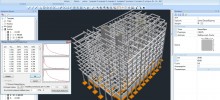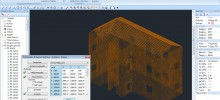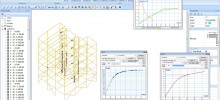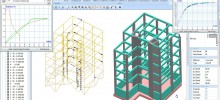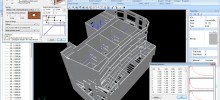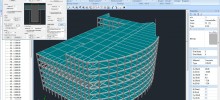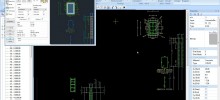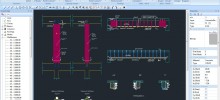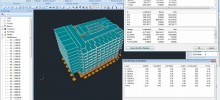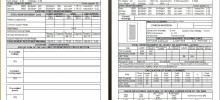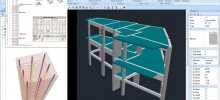Detailed Description
The add-on “Retrofit for Concrete” contains the Eurocode 8, Part 3 (EN1998-3) provisions and design checks for the assessment and redesign of existing buildings and for the application of reinforcement technics to existing columns and beams cross-sections.
The structure can be analyzed by applying the nonlinear static analysis method. It also includes production of the construction plans, formworks and reinforcement detailing, the bill of materials and full production of the technical report.
Prerequisites:
Analysis Methods
- Preliminary design performing linear static analysis method
- Preliminary design performing response spectrum analysis method
- Linear static analysis considering two methods based on (i) the behavior factor q and (ii) the local ductility factors m
- Response spectrum analysis considering two methods based on (i) the uniform behavior factor q and (ii) the local ductility factors m
- Nonlinear static analysis method (Pushover)
The nonlinear static analysis (Pushover) leads to a more reliable estimation of the structural performance, a more realistic assessment of the deformed structure and provide information about the performance of the structural elements that cannot provide the linear analysis methods.
The main scope of a nonlinear analysis is the assessment and the calculation of the nonlinear deformations as well as the stress resultants on the structure under seismic loads.
According to the Pushover analysis, horizontal lateral loads are applied on the structural model as well as the corresponding nodes and structural elements.
The distribution of the lateral loads along height (uniform, rectangular, triangular) is defined according to the seismic inertia forces.
The lateral loads are increased incrementally until the structure turns to mechanism and collapse.
During the analysis, once a cross-section yields (development of a plastic hinge) the model is modified properly and the incremental process of the lateral loads continues.
The control check is based on a nonlinear relation of the bending moment – plastic hinge rotation defined for each structural member.
For each analysis step is examined if the value of the bending moments developed on the structural element exceed the corresponding value of the yield moment.
In case there is an excess of the yield moment, a plastic hinge is developed in the edge of the element.
In each step of the Pushover analysis, is also calculated the base shear force and the corresponding translation of a characteristic node (“control node”), usually located on top floor of the structure.
The main result of the pushover analysis is the derivation of the Force (base shear) – Displacement curve, also called capacity curve.
The curve derived from the pair values of the base shear force – top floor displacement is representative for the structural performance under seismic loading.
The nonlinear static analysis, also, provides information and complete supervision of the generating sequence of the plastic hinges on the structural elements.
The engineer has a complete display of each step of the gradual deformed structure and so can easily and quickly detects the “weak” regions of the structure.
In SCADA Pro the nonlinear analysis method is fully implemented.
All the requisite analyses are performed automatically considering default parameters, all the performance criteria according to EN1998-3 provisions are checked automatically and the corresponding results are presented in a direct and supervisory way.
Seismic Design - Design Checks (EN1998-3)
In the preliminary design are checked the criteria of EN1998-3 fulfilled in order to be applied either linear or nonlinear analysis and the corresponding results as well as the insufficiency indices λ are print out.
In the linear elastic analysis there is the option of two methods:
- the uniform behavior facto q method and
- the local ductility factors m method.
Also, the check about the evaluation of either brittle or ductile behavior of the structural elements is applied according two three criteria of EN1998-3:
- the moment shear ratio αs,
- the ductility demand ratio in terms of curvatures μ1/r,
- the ductility demand ratio in terms of deformations μd.
It is also taken into consideration the effect of the presence of masonry infills in the structure according to the EN1998-3 provisions and it is automatically calculated their capacity.
[infobox color=”#7bb0d8″ icon=”arrow-right”]Nonlinear static analysis (Pushover)[/infobox]
In SCADA Pro all the requisite seismic load combinations are included based on rectangular or triangular distribution of the lateral loads.
The target displacement is calculated according to EN1998-3 and EN1998-1-1, Annex B provisions.
The capacity curve and the equivalent bilinear curve are drawn for the corresponding “control node”.
Along the capacity curve, the target displacements are depicted that correspond to each performance level.
There is also the capability, the masonry infills to be included to the structural model and their capacity to be calculated automatically in each step of the Pushover analysis.
Assessment – Redesign of an existing reinforced concrete structure (EN1998-3)
In SCADA Pro all the provisions of the EN1998-3 regarding the assessment and redesign of the existing reinforced concrete structures have been incorporated.
So, through the editors the user can :
- configure the existing steel reinforcement easily and quickly,
- perform a preliminary analysis to check whether the criteria for the application of an elastic (static or dynamic) or inelastic analysis (Pushover) are fulfilled and finally
- receive the results of the design checks in terms of forces or deformations following the main analysis.
Regarding the process of redesign and reinforcement of the structure, all retrofitting materials proposed in EN1998-3 are included in SCADA Pro.
- Columns: reinforced cast concrete jacket, shotcrete jacket, fiber reinforced polymers (FRPs), steel laminates, confinement methods.
- Beams: Cast concrete layers, shotcrete layers, fiber reinforced polymers (FRPs), steel laminates
The new ultimate moment resistance is calculated automatically based on the interaction diagrams M-N of the composite cross- section of different materials (old – new material), all design checks proposed in EN1998-3 are carried out and the appropriate number of dowels is calculated automatically according to the construction provisions/limitations.
The materials made by Sika Company, about the rehabilitation, protection and reinforcement of structural elements, have been included, as well as an application for the calculation of chemical and mechanical anchors made by Fischer Company.
A brief presentation of the assessment and redesign of a structure follows according to EN1998-3
The Eurocode 8, Part 3 (EN1998-3) is a set of regulations for the assessment and redesign of the existing reinforced concrete structures.
The provisions of EN1998-3 are implemented through a process of trial and error.
Initially, the existing structure is assessed, then retrofitted in accordance with the provisions of EN1998-3 is assessed again, until the process of reinforcement is adequate and the structure meets the performance criteria.
The application of EN1998-3 is necessary both for the reinforcement of existing structures designed in accordance with old design codes or for the rehabilitation of damaged structures.
EN1998-3 is based on the performance-based design philosophy.
For the performance based design should be defined at first the hazard levels, which are related to the seismicity and the geological characteristics of the region of interest, where the examined structure is located.
For example, in Greece, two levels of seismic hazard are considered (10 % probability of exceedance in 50 years, 50 % probability of exceedance in 50 years).
The second step is the definition of the damage levels or otherwise the performance levels.
The structural damage is usually quantified for each structural member and not for the structure in total.
Thus, the damage level according to EN1998-3 is determined by the value of the chord rotation angle at the ends of the structural member.
Therefore, different values of the chord rotation angle correspond to different performance levels.
According to EN1998-3 the performance levels are the Immediate Occupancy (A)*, Life Safety (B)* and collapse prevention (C)*.
The performance criteria to be met according to the basic principles of EN1998-3 is the combination of a seismic hazard level with a performance level .
That means, that the engineer/user defines the required performance level of the structure for a given seismic hazard level.
*In EN1998-3 the corresponding performance levels are Damage Limitation, Significant Damage and Near Collapse.
[infobox color=”#7bb0d8″ icon=”arrow-right”]Assessment[/infobox]
The assessment procedure involves the estimation of the capacity of the structure and the demand for a given seismic hazard level.
The capacity of a structure is estimated with nonlinear analysis methods, static or dynamic.
In EN1998-3, the use either nonlinear or linear analysis methods as well as a combination of the two is proposed.
Assessment applying linear analysis methods
Two linear analysis methods are used; the uniform behavior factor q method and the local ductility indices m in order for the nonlinear structural behavior of the structural elements to be taken into account.
The performance of the structural elements is assessed in terms of forces, where the safety inequality is verified, i.e. the load action applied on the member should not exceed its resistance.
Assessment applying static nonlinear analysis methods
The nonlinear static analysis method (Pushover Analysis) is usually applied for the assessment of a structure , where a lateral distributed load along the height is imposed on the structure and it is gradually increased until the collapse.
The capacity of the structure is presented with a load – displacement curve.
In EN1998-3, the capacity curve is displayed in terms of base shear versus the roof displacement, which is the displacement of a characteristic node on the top floor of the structure.
The demand is estimated by applying the Displacement Coefficient Method, where a target displacement (i.e. a characteristic value of the roof displacement) is calculated for a specific seismic hazard level.
The target displacement, given the capacity curve is indicative for the structural performance of the examined structure.
The structural elements for the specific target displacement should satisfy the acceptable performance level.
Assessment applying dynamic nonlinear analysis method
In case of the application of nonlinear dynamic analysis, a set of accelerograms are selected, where the peak ground acceleration corresponds to a specific hazard level.
When the dynamic structural analysis is completed, the damage level is estimated on the ends of the structural elements, for each time step.
The performance level of a structural element for a specific deformed state of the structure is estimated based on the values of several engineering demand parameters.
According to EN1998-3, the engineering demand parameter considered is the chord rotation angle considering concentrated plasticity.
The performance levels are defined as a combination of the yield and the ultimate chord rotation angle θy and θu, respectively.
Since the chord rotation angle expresses the deformation of the structural element under bending, the shear resistance check is also carried out in terms of forces.
[infobox color=”#7bb0d8″ icon=”arrow-right”]Redesign [/infobox]
If the structure doesn’t meet the performance criteria, it means that the structure sustains more damage than the acceptable for a given earthquake hazard level.
So, retrofitting methods (rehabilitation & reinforcement) should be applied in order to increase the stiffness or the ductility of the vulnerable structural members.
| In the second part of EN1998-3, the retrofitting methods with the objective to increase the local ductility and the stiffness are presented: | |
| Rehabilitation and reinforcement of columns |
|
| Reinforcement of beams |
|
| Reinforcement of joints |
|
| Reinforcement of frames |
|
| Conversion of frames to shear walls |
|
| Foundation reinforcement |
|
Part of the retrofitting methods is a number of modern composite or standard materials.
In the case of beams and columns, the retrofitting materials used are mainly new types of concrete, steel laminates, carbon-fiber reinforced concrete laminates and FRP fabric strips.
The most common retrofitting materials are:
Special types of concrete
- Cast concrete
- FRP concrete
- Shotcrete
- FRP shotcrete
Polymer adhesives
- Resin injections
Rehabilitation mortars
- Polymer-modified mortars
- Cement mortars
Bonded steel stripes or laminatesBonded FRP fabric stripes or laminatesShear connectors
- Anchors
- Dowels
- Single shear connectors
- Double shear connectors
Anchorages and welding of new reinforcing bars
- Rigid links
- Flexible links
- Suspensors
The methods and the materials for the rehabilitation and the reinforcement of the structural elements presented above are enriched with the materials and retrofitting technics included in SCADA Pro, made by the Sika Company.
Creation of structural drawings – Layout and detailing of reinforcement (EC2)
SCADA Pro provides a modern stand-alone editor for the creation of structural drawings.
A rich toolbox is offered, that contains ready-to-use symbols, annotations and sketching details, as well as special commands.
Any edit is incorporated, real time, in the drawings, including automatic re-check of the section takes place.
After that, the reinforcement is updated in the editing environment.
The layout of the beams’ reinforcement may be automatically derived with the respective bending moment diagrams.
The layout of a column’s reinforcement may be derived either for a certain level or for its whole height. The structural drawings may be exported in a .dwg or a .dxf file type.
Bill of materials
SCADA Pro produces the quantities of all the materials of a project in a well-organized tabular form.
For the concrete, the quantities are presented per type of structural member (beams, columns etc.), per level or for the entire structure.
For the reinforcement, the quantities are presented per type of structural member, per each member or per bar diameter.
This grouping is available for each floor or for the entire structure.
Similarly, for steel structures, the bill of materials is available per floor, per member’s section or per type of structural member (columns, beams, girders, purlins, bracing etc.).
Report of the project
In SCADA Pro the user simply selects the sections to be included in the report of the project.
Simple tools allow the user to edit the report header and footer position chapters and create automatically the table of contents.
Beams’ results also include envelope diagrams of internal forces.
The report may be previewed before the user can save it for further editing in one of the following file formats: RTF, PDF, HTML, PPTX, XLSX.
The results of both the assessment – redesign of the reinforced concrete structures as well as the design of loadbearing masonry structures are also presented in a well-organized, format.
Accompanying drawings and other details are also available and included for better reporting.



